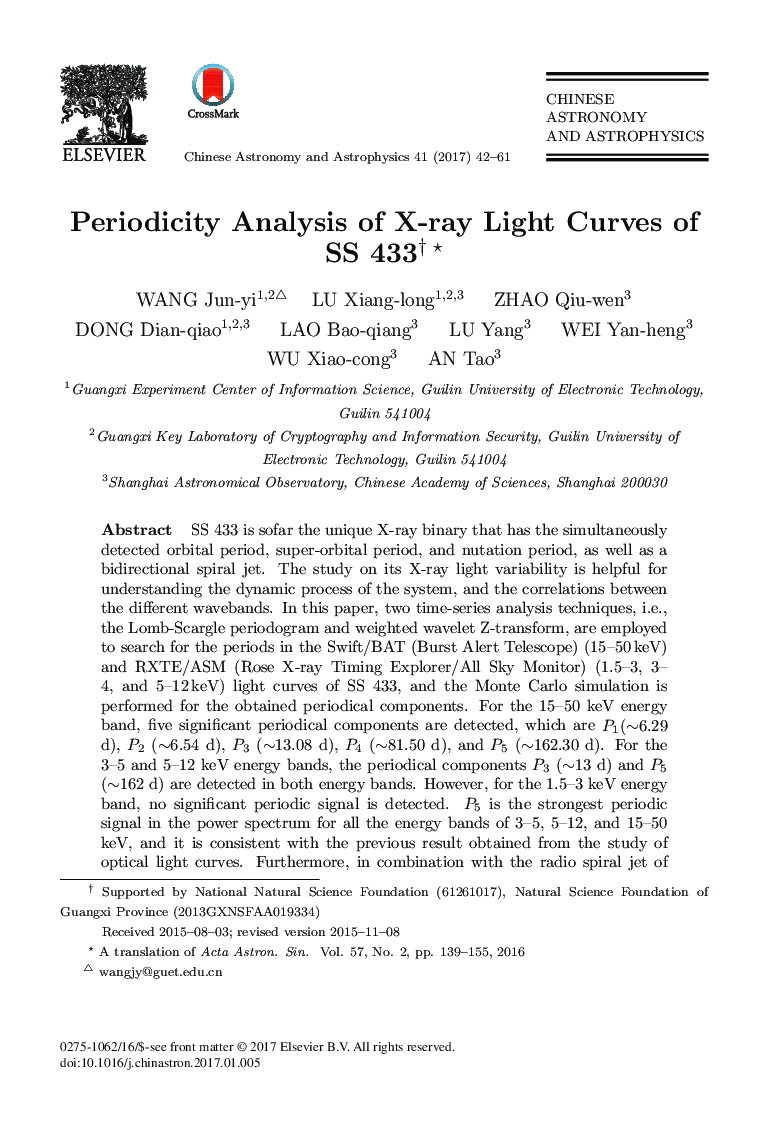| Article ID | Journal | Published Year | Pages | File Type |
|---|---|---|---|---|
| 8133342 | Chinese Astronomy and Astrophysics | 2017 | 20 Pages |
Abstract
SS 433 is sofar the unique X-ray binary that has the simultaneously detected orbital period, super-orbital period, and nutation period, as well as a bidirectional spiral jet. The study on its X-ray light variability is helpful for understanding the dynamic process of the system, and the correlations between the different wavebands. In this paper, two time-series analysis techniques, i.e., the Lomb-Scargle periodogram and weighted wavelet Z-transform, are employed to search for the periods in the Swift/BAT (Burst Alert Telescope) (15-50 keV) and RXTE/ASM (Rose X-ray Timing Explorer/All Sky Monitor) (1.5-3, 3- 4, and 5-12 keV) light curves of SS 433, and the Monte Carlo simulation is performed for the obtained periodical components. For the 15-50 keV energy band, five significant periodical components are detected, which are P1(â¼6.29 d), P2 (â¼6.54 d), P3 (â¼13.08 d), P4 (â¼81.50 d), and P5 (â¼162.30 d). For the 3-5 and 5-12 keV energy bands, the periodical components P3 (â¼13 d) and P5 (â¼162 d) are detected in both energy bands. However, for the 1.5-3 keV energy band, no significant periodic signal is detected. P5 is the strongest periodic signal in the power spectrum for all the energy bands of 3-5, 5-12, and 15-50 keV, and it is consistent with the previous result obtained from the study of optical light curves. Furthermore, in combination with the radio spiral jet of SS 433, it is suggested that the X-ray and optical variability of P5 (â¼162 d) is probably related to the precession of its relativistic jet. The high correlation between the X-ray and optical light curves may also imply that the X-ray and optical radiations are of the same physical origin. P3 shows a good agreement with the orbital period (â¼13.07 d) obtained by the previous study, and P2 and P4 are respectively the high-frequency harmonics of P3 and P5. P1 is detected only in the power spectrum of the 15-50 keV energy band, and it is consistent with the nutation period of the system. As the energy of energy band decreases (from hard X-ray to soft X-ray), the number of detected periods becomes gradually less, this result verifies that the radiation in the high-energy band (hard X-ray) comes primarily from the jet, and the radiation in the low-energy band (soft X-ray) may be dominated by the medium around the binary system. The multiple X-ray periods obtained from the present study have provided a reliable basis for the further analysis of the multi-band data of SS 433, and the study on the dynamical mechanism of the system.
Keywords
Related Topics
Physical Sciences and Engineering
Physics and Astronomy
Astronomy and Astrophysics
Authors
Wang Jun-yi, Lu Xiang-long, Zhao Qiu-wen, Dong Dian-qiao, Lao Bao-qiang, Lu Yang, Wei Yan-heng, Wu Xiao-cong, An Tao,
